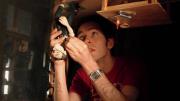When he talks about stop-motion animation, Timothy Reckart ’09 gets onomatopoetic. Boingggg conveys the “nice, natural motion blur” of a claymation monster’s party-favor tongue grabbing its lunch. Brrrr evokes the rippling fingerprints left by animators on puppets’ Plasticine skin. These descriptions are efficiently vivid; the process itself is laborious. Move an object by a hair’s breadth, step away, hit the camera’s button. Repeat, frame by frame.
Though he used to try to keep characters in constant motion, Reckart has learned to structure his choreography around a few key poses, an approach that “has a lot more clarity” while saving time and effort. Animators are also resourceful in other ways, he reports: “A stop-motion studio is the type of place where people don’t throw away their water bottles, because we might be able to use them for something” (as he once hoarded empty pizza boxes for set-building material). But even as stop-motion rewards “crafty” practicality, the work is also emotional. It is, in his words, a form of “acting in slow motion,” breaking down an emotion into external components: clenched fingers, hunched shoulders, a well-timed blink.
“Live-action actors, I think, act from the inside out,” he says. “They try to get to an emotional place and then let that emotional place dictate the details of what they do physically. It’s the reverse for animation, where we have to act from the outside in.” When planning an action, he explains, “I think, ‘Well, how would I do it?’ That’s how you kind of distill it down to the gestures—you have to act it out yourself.“ Inevitably, the animator’s personal intuitions about bodily kinetics and behavior imprint on the character.
Stop-motion performance is a collaborative art, splitting the work three ways: the artist designs the character’s look; the actor gives it a voice; the animator manipulates the puppet. Ironically, though, stop-motion first appealed to Reckart as a solitary pursuit. In college, animation let him make movies in a room by himself; stop-motion let him do that despite not knowing how to draw. “I had a kind of cold-blooded calculation about it,” he admits, readily. A lot of his classmates wanted to make movies, but few wanted careers in stop-motion—“which is miserable drudgery for most people”—so he pursued the path where he had “comparative advantage.”
That led to film school in London, where classmates in music composition, set design, and other departments comprised a ready-made crew for Reckart’s final thesis. The 10-minute Head over Heels concerns an old couple who have opposite perspectives: the husband walks on the floor, the wife on the ceiling. This metaphor-made-literal could have been cutesy. But stop-motion, with all its deliberate detail, makes the story feel homely and lived-in. Mundane tasks like frying eggs or tying shoelaces become oddly poignant.
The short’s Oscar nomination in 2013 offered Reckart, then struggling in New York, a ticket to Los Angeles and sunnier professional climes: “The volume of work is so much greater, it’s like night and day.” His first gig was Anomalisa, which explored loneliness using silicone puppets. Then came more cheerful assignments: the madcap sitcom Community and a children’s program, Tumble Leaf. Other projects were a crowd-founded video game and a music video for a band from his hometown, Tucson—small, handcrafted passion projects.
But Reckart always dreamed of working big. Raised on crowd-pleasers like Jurassic Park and Honey, I Shrunk the Kids, he aspired to enter the studio system and make the kind of movie that opens wide. He got his chance when Sony Pictures Animations recruited him to direct a computer-animated Nativity story about a donkey. “Animals in animation will never go away,” observes Reckart. “Because animation’s expensive and time-consuming, if you’re going to make a movie in animation, oftentimes your question is, ‘Why are you using animation to tell this?’ Because the animals talk. That’s a very clean, clear, obvious answer.” They’re also broadly relatable, he adds: “The nice thing about animals is that they represent this middle ground between adults and children.”
The Star will come out in November 2017, and beyond that horizon, Reckart seems open to anything. He expresses interest in television, or working in live action. Compared to stop-motion, the latter is gratifyingly quick. His live action short (which is premiering at the 2016 Austin Film Festival in October) took two days to shoot, he marvels: “You can spend two days on one shot in animation.” The trade-off is control. “In animation they use this word, ‘iteration,’” he explains. “You can have a character design, and get another draft, and get another draft, and keep sending notes, and perfecting it, perfecting it, until you get the perfect thing. And in live action, it’s like, ‘Uh, here’s what we’ve got. Do you want the red one or the blue one? If you wanted a purple one, too bad. We’ve got red and blue.’ ” Fitting, then, that Grand Opening follows a married couple on their restaurant’s lackluster first day—a fable, says Reckart, about making the best of imperfect circumstances. Or, perhaps, about labors of love.














